Analyzing Sustainability at Gilligans Cairns Backpacker Hotel
VerifiedAdded on 2023/06/12
|14
|3826
|162
Report
AI Summary
This report provides a detailed analysis of the sustainability practices at Gilligans Cairns backpacker hotel & resort. It begins with an introduction to sustainable business practices and their importance in today's market, highlighting the role of environmental, social, and financial factors. The report then focuses on Gilligans Cairns, describing its business model and its appeal to young visitors seeking a party environment. The three dimensions of sustainability—economic, social, and environmental—are discussed in the context of the hotel's operations, with a specific focus on social sustainability initiatives. These initiatives include partnerships with wildlife protection offices and health awareness campaigns. The report also assesses the hotel's efforts in energy and water waste reduction, recycling programs, and environmentally responsible vendor selection. The Pressure State Response (PSR) model is employed to monitor the sustainability of the hotel, identifying challenges related to land use and conservation. The report recommends strengthening public awareness of biodiversity concerns and supporting biodiversity corridors to further enhance the hotel's sustainable practices. Desklib provides a platform for students to access past papers and solved assignments like this for academic support.
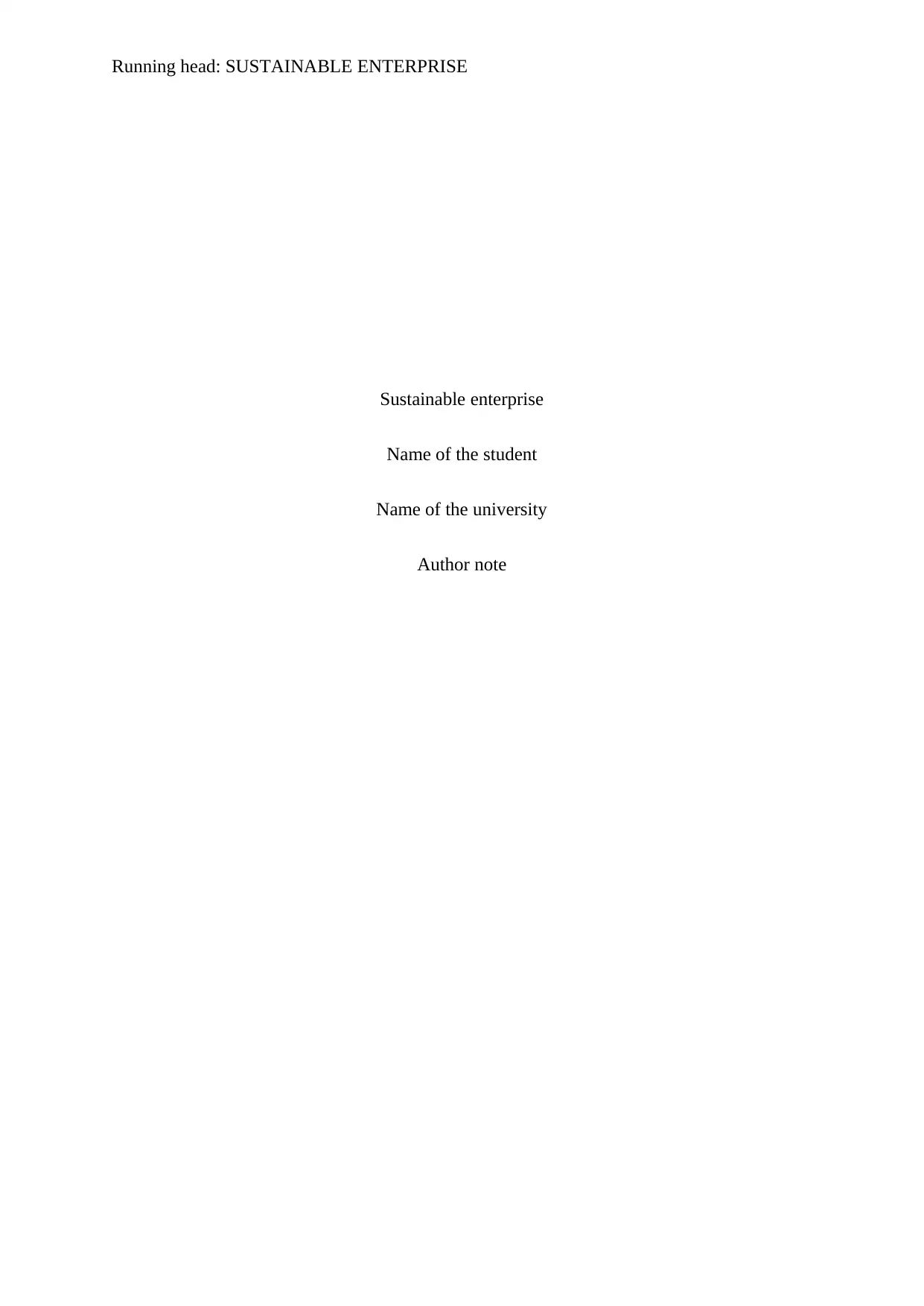
Running head: SUSTAINABLE ENTERPRISE
Sustainable enterprise
Name of the student
Name of the university
Author note
Sustainable enterprise
Name of the student
Name of the university
Author note
Paraphrase This Document
Need a fresh take? Get an instant paraphrase of this document with our AI Paraphraser
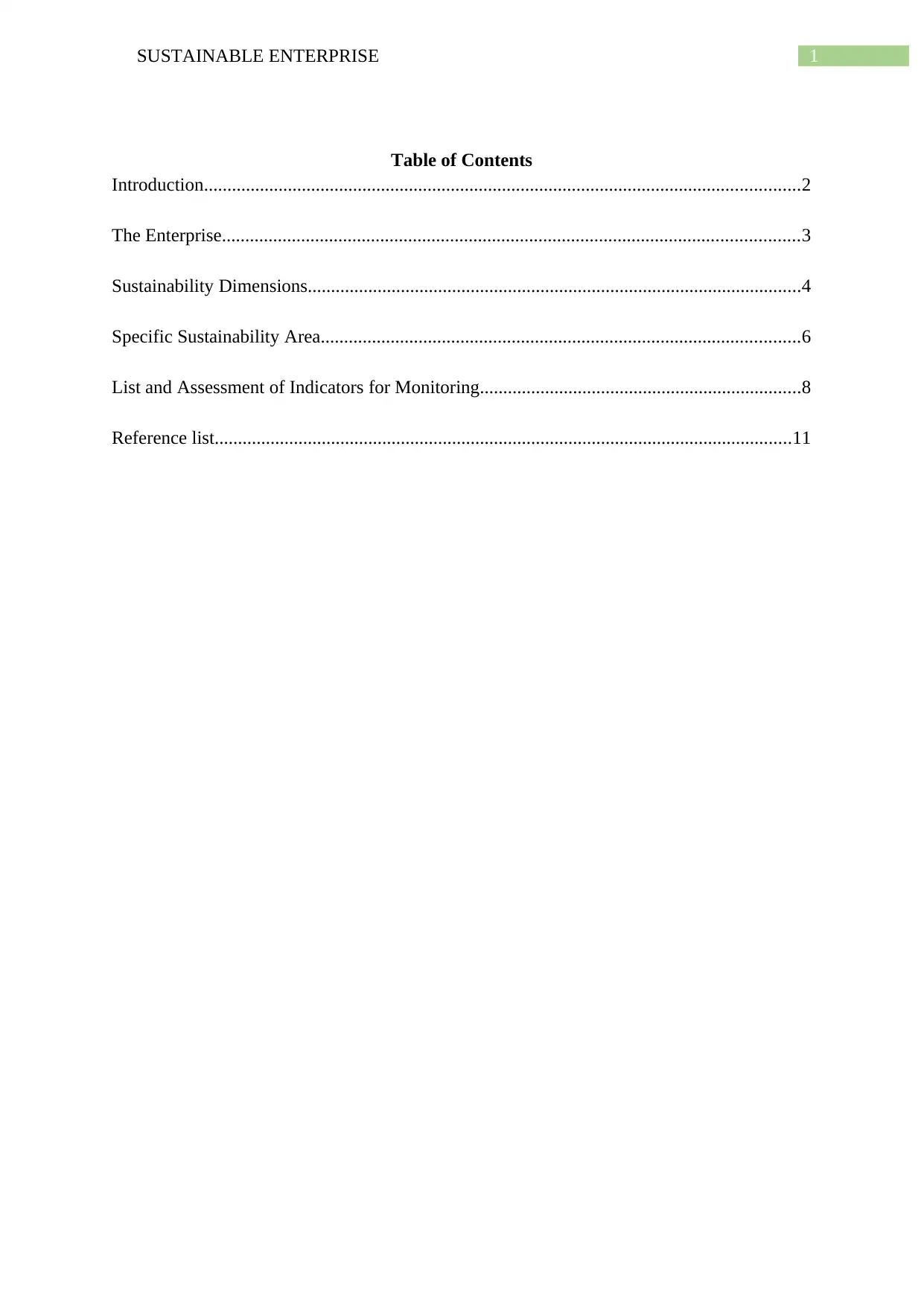
1SUSTAINABLE ENTERPRISE
Table of Contents
Introduction................................................................................................................................2
The Enterprise............................................................................................................................3
Sustainability Dimensions..........................................................................................................4
Specific Sustainability Area.......................................................................................................6
List and Assessment of Indicators for Monitoring.....................................................................8
Reference list............................................................................................................................11
Table of Contents
Introduction................................................................................................................................2
The Enterprise............................................................................................................................3
Sustainability Dimensions..........................................................................................................4
Specific Sustainability Area.......................................................................................................6
List and Assessment of Indicators for Monitoring.....................................................................8
Reference list............................................................................................................................11
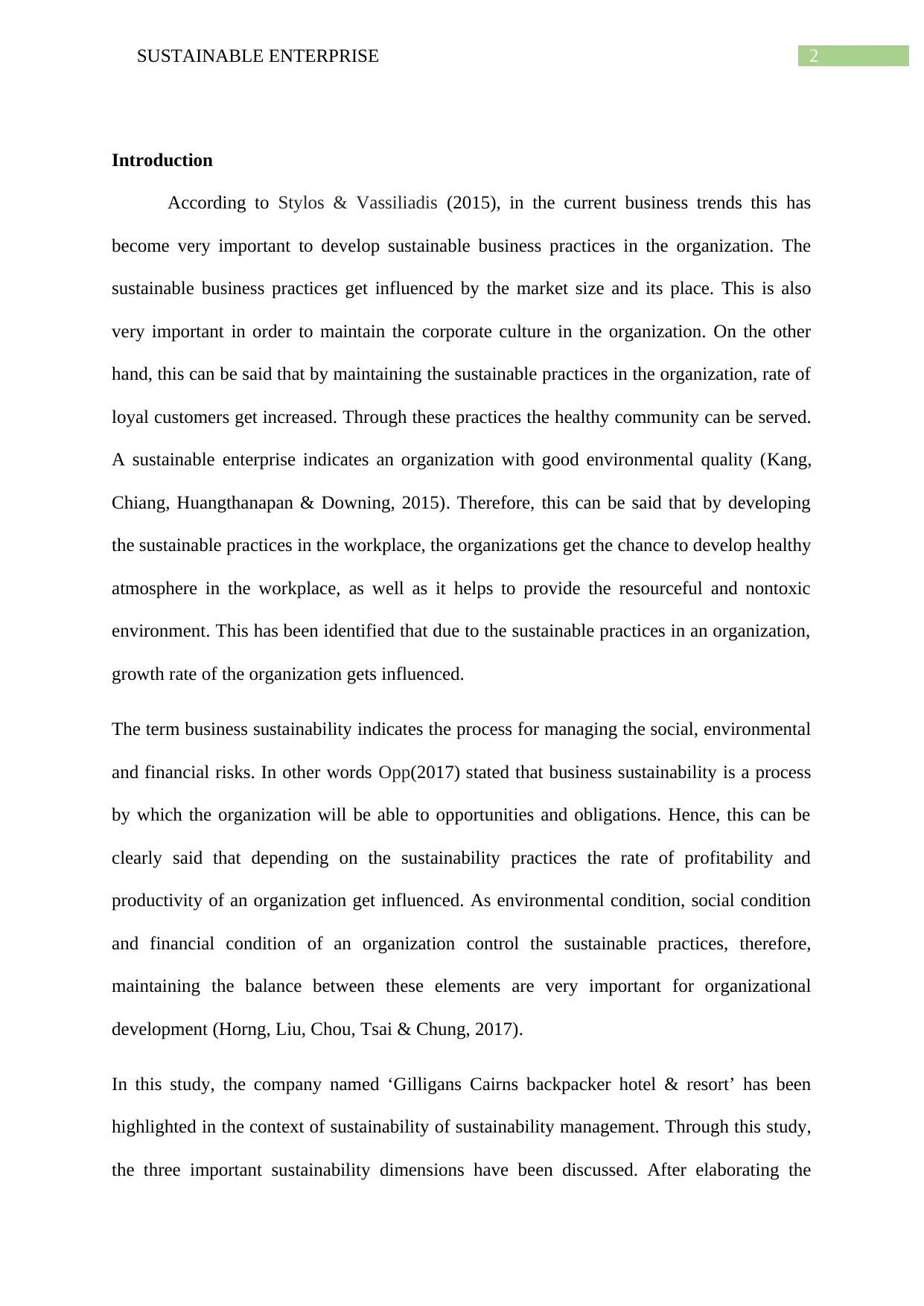
2SUSTAINABLE ENTERPRISE
Introduction
According to Stylos & Vassiliadis (2015), in the current business trends this has
become very important to develop sustainable business practices in the organization. The
sustainable business practices get influenced by the market size and its place. This is also
very important in order to maintain the corporate culture in the organization. On the other
hand, this can be said that by maintaining the sustainable practices in the organization, rate of
loyal customers get increased. Through these practices the healthy community can be served.
A sustainable enterprise indicates an organization with good environmental quality (Kang,
Chiang, Huangthanapan & Downing, 2015). Therefore, this can be said that by developing
the sustainable practices in the workplace, the organizations get the chance to develop healthy
atmosphere in the workplace, as well as it helps to provide the resourceful and nontoxic
environment. This has been identified that due to the sustainable practices in an organization,
growth rate of the organization gets influenced.
The term business sustainability indicates the process for managing the social, environmental
and financial risks. In other words Opp(2017) stated that business sustainability is a process
by which the organization will be able to opportunities and obligations. Hence, this can be
clearly said that depending on the sustainability practices the rate of profitability and
productivity of an organization get influenced. As environmental condition, social condition
and financial condition of an organization control the sustainable practices, therefore,
maintaining the balance between these elements are very important for organizational
development (Horng, Liu, Chou, Tsai & Chung, 2017).
In this study, the company named ‘Gilligans Cairns backpacker hotel & resort’ has been
highlighted in the context of sustainability of sustainability management. Through this study,
the three important sustainability dimensions have been discussed. After elaborating the
Introduction
According to Stylos & Vassiliadis (2015), in the current business trends this has
become very important to develop sustainable business practices in the organization. The
sustainable business practices get influenced by the market size and its place. This is also
very important in order to maintain the corporate culture in the organization. On the other
hand, this can be said that by maintaining the sustainable practices in the organization, rate of
loyal customers get increased. Through these practices the healthy community can be served.
A sustainable enterprise indicates an organization with good environmental quality (Kang,
Chiang, Huangthanapan & Downing, 2015). Therefore, this can be said that by developing
the sustainable practices in the workplace, the organizations get the chance to develop healthy
atmosphere in the workplace, as well as it helps to provide the resourceful and nontoxic
environment. This has been identified that due to the sustainable practices in an organization,
growth rate of the organization gets influenced.
The term business sustainability indicates the process for managing the social, environmental
and financial risks. In other words Opp(2017) stated that business sustainability is a process
by which the organization will be able to opportunities and obligations. Hence, this can be
clearly said that depending on the sustainability practices the rate of profitability and
productivity of an organization get influenced. As environmental condition, social condition
and financial condition of an organization control the sustainable practices, therefore,
maintaining the balance between these elements are very important for organizational
development (Horng, Liu, Chou, Tsai & Chung, 2017).
In this study, the company named ‘Gilligans Cairns backpacker hotel & resort’ has been
highlighted in the context of sustainability of sustainability management. Through this study,
the three important sustainability dimensions have been discussed. After elaborating the
⊘ This is a preview!⊘
Do you want full access?
Subscribe today to unlock all pages.

Trusted by 1+ million students worldwide
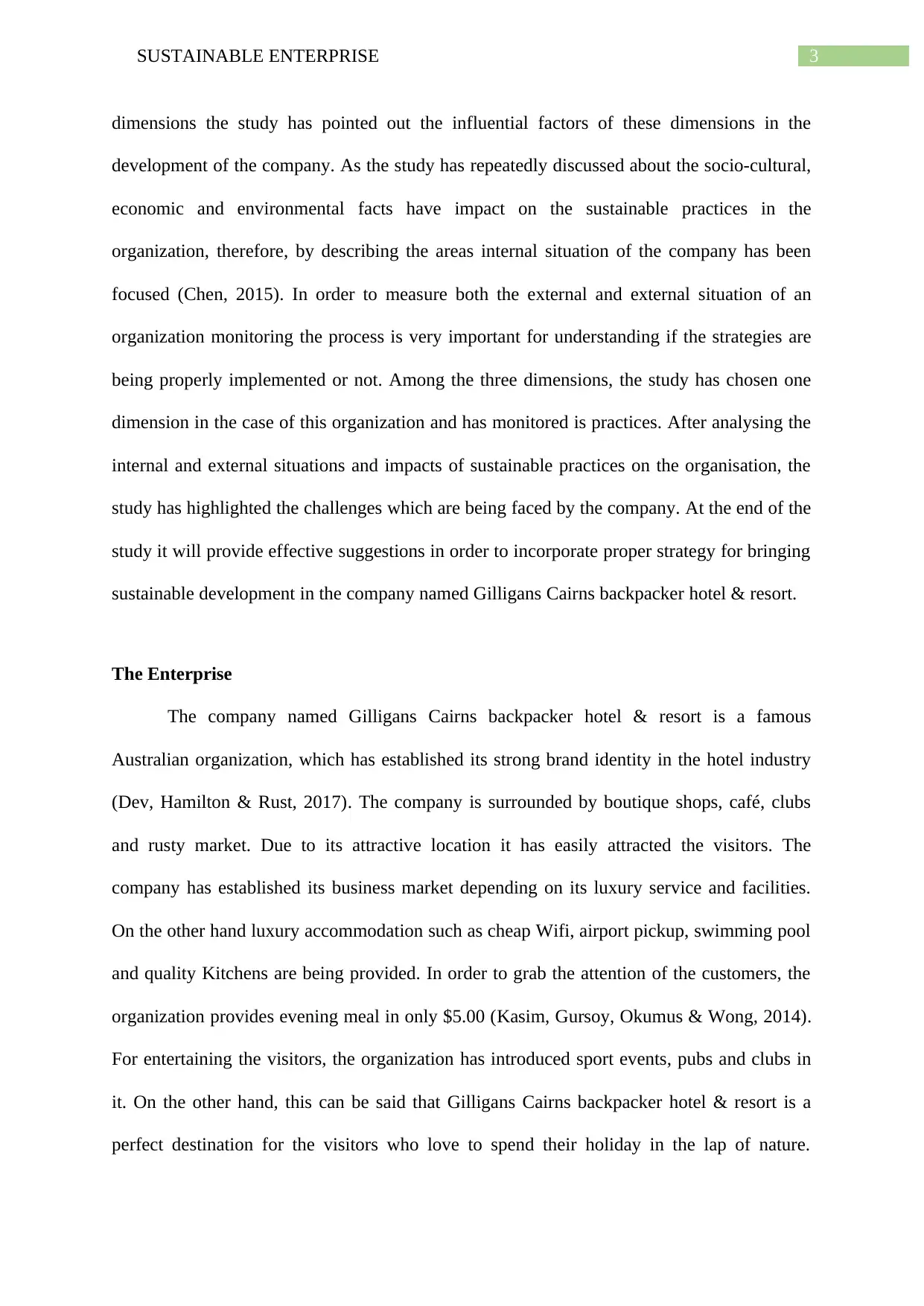
3SUSTAINABLE ENTERPRISE
dimensions the study has pointed out the influential factors of these dimensions in the
development of the company. As the study has repeatedly discussed about the socio-cultural,
economic and environmental facts have impact on the sustainable practices in the
organization, therefore, by describing the areas internal situation of the company has been
focused (Chen, 2015). In order to measure both the external and external situation of an
organization monitoring the process is very important for understanding if the strategies are
being properly implemented or not. Among the three dimensions, the study has chosen one
dimension in the case of this organization and has monitored is practices. After analysing the
internal and external situations and impacts of sustainable practices on the organisation, the
study has highlighted the challenges which are being faced by the company. At the end of the
study it will provide effective suggestions in order to incorporate proper strategy for bringing
sustainable development in the company named Gilligans Cairns backpacker hotel & resort.
The Enterprise
The company named Gilligans Cairns backpacker hotel & resort is a famous
Australian organization, which has established its strong brand identity in the hotel industry
(Dev, Hamilton & Rust, 2017). The company is surrounded by boutique shops, café, clubs
and rusty market. Due to its attractive location it has easily attracted the visitors. The
company has established its business market depending on its luxury service and facilities.
On the other hand luxury accommodation such as cheap Wifi, airport pickup, swimming pool
and quality Kitchens are being provided. In order to grab the attention of the customers, the
organization provides evening meal in only $5.00 (Kasim, Gursoy, Okumus & Wong, 2014).
For entertaining the visitors, the organization has introduced sport events, pubs and clubs in
it. On the other hand, this can be said that Gilligans Cairns backpacker hotel & resort is a
perfect destination for the visitors who love to spend their holiday in the lap of nature.
dimensions the study has pointed out the influential factors of these dimensions in the
development of the company. As the study has repeatedly discussed about the socio-cultural,
economic and environmental facts have impact on the sustainable practices in the
organization, therefore, by describing the areas internal situation of the company has been
focused (Chen, 2015). In order to measure both the external and external situation of an
organization monitoring the process is very important for understanding if the strategies are
being properly implemented or not. Among the three dimensions, the study has chosen one
dimension in the case of this organization and has monitored is practices. After analysing the
internal and external situations and impacts of sustainable practices on the organisation, the
study has highlighted the challenges which are being faced by the company. At the end of the
study it will provide effective suggestions in order to incorporate proper strategy for bringing
sustainable development in the company named Gilligans Cairns backpacker hotel & resort.
The Enterprise
The company named Gilligans Cairns backpacker hotel & resort is a famous
Australian organization, which has established its strong brand identity in the hotel industry
(Dev, Hamilton & Rust, 2017). The company is surrounded by boutique shops, café, clubs
and rusty market. Due to its attractive location it has easily attracted the visitors. The
company has established its business market depending on its luxury service and facilities.
On the other hand luxury accommodation such as cheap Wifi, airport pickup, swimming pool
and quality Kitchens are being provided. In order to grab the attention of the customers, the
organization provides evening meal in only $5.00 (Kasim, Gursoy, Okumus & Wong, 2014).
For entertaining the visitors, the organization has introduced sport events, pubs and clubs in
it. On the other hand, this can be said that Gilligans Cairns backpacker hotel & resort is a
perfect destination for the visitors who love to spend their holiday in the lap of nature.
Paraphrase This Document
Need a fresh take? Get an instant paraphrase of this document with our AI Paraphraser
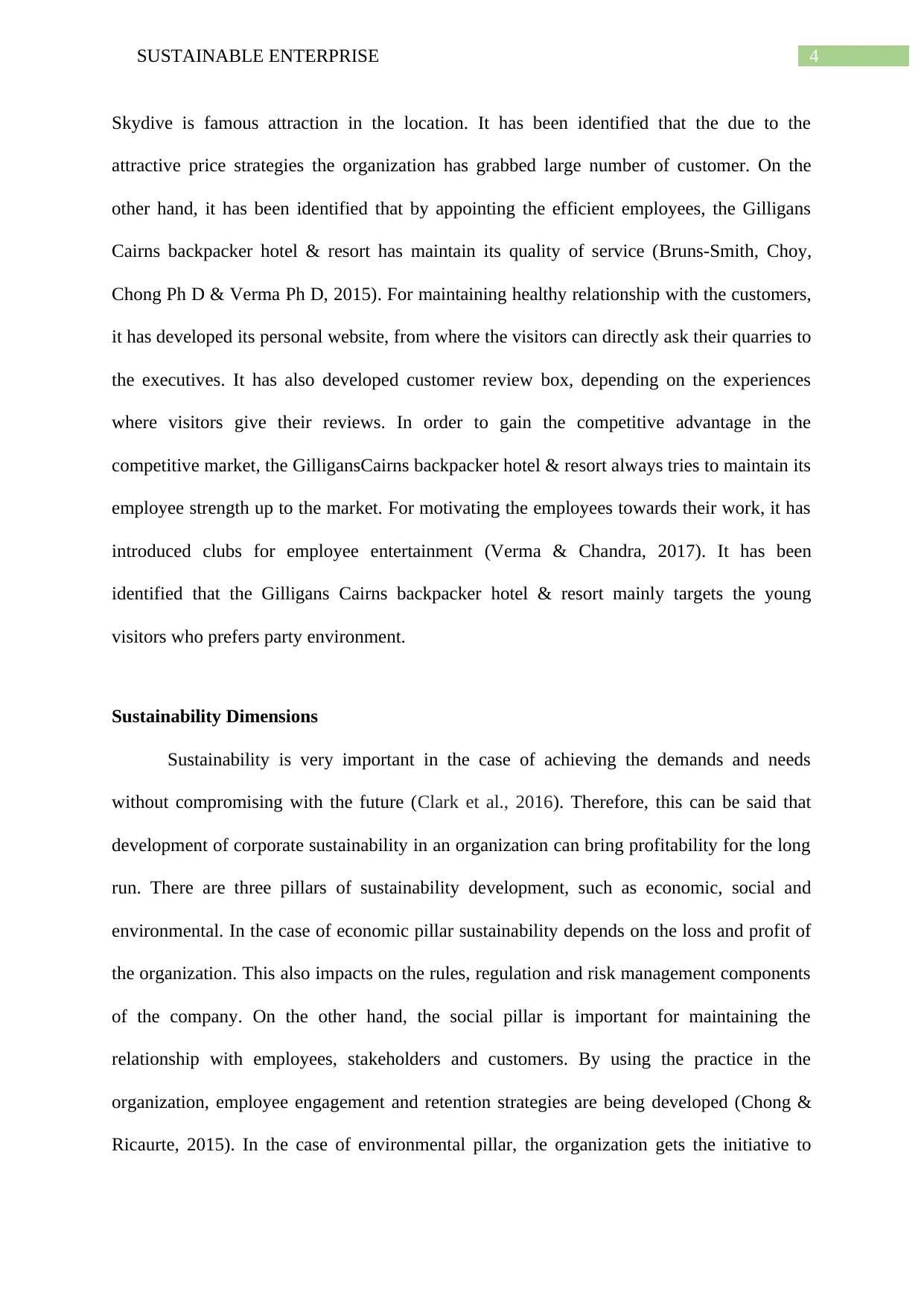
4SUSTAINABLE ENTERPRISE
Skydive is famous attraction in the location. It has been identified that the due to the
attractive price strategies the organization has grabbed large number of customer. On the
other hand, it has been identified that by appointing the efficient employees, the Gilligans
Cairns backpacker hotel & resort has maintain its quality of service (Bruns-Smith, Choy,
Chong Ph D & Verma Ph D, 2015). For maintaining healthy relationship with the customers,
it has developed its personal website, from where the visitors can directly ask their quarries to
the executives. It has also developed customer review box, depending on the experiences
where visitors give their reviews. In order to gain the competitive advantage in the
competitive market, the GilligansCairns backpacker hotel & resort always tries to maintain its
employee strength up to the market. For motivating the employees towards their work, it has
introduced clubs for employee entertainment (Verma & Chandra, 2017). It has been
identified that the Gilligans Cairns backpacker hotel & resort mainly targets the young
visitors who prefers party environment.
Sustainability Dimensions
Sustainability is very important in the case of achieving the demands and needs
without compromising with the future (Clark et al., 2016). Therefore, this can be said that
development of corporate sustainability in an organization can bring profitability for the long
run. There are three pillars of sustainability development, such as economic, social and
environmental. In the case of economic pillar sustainability depends on the loss and profit of
the organization. This also impacts on the rules, regulation and risk management components
of the company. On the other hand, the social pillar is important for maintaining the
relationship with employees, stakeholders and customers. By using the practice in the
organization, employee engagement and retention strategies are being developed (Chong &
Ricaurte, 2015). In the case of environmental pillar, the organization gets the initiative to
Skydive is famous attraction in the location. It has been identified that the due to the
attractive price strategies the organization has grabbed large number of customer. On the
other hand, it has been identified that by appointing the efficient employees, the Gilligans
Cairns backpacker hotel & resort has maintain its quality of service (Bruns-Smith, Choy,
Chong Ph D & Verma Ph D, 2015). For maintaining healthy relationship with the customers,
it has developed its personal website, from where the visitors can directly ask their quarries to
the executives. It has also developed customer review box, depending on the experiences
where visitors give their reviews. In order to gain the competitive advantage in the
competitive market, the GilligansCairns backpacker hotel & resort always tries to maintain its
employee strength up to the market. For motivating the employees towards their work, it has
introduced clubs for employee entertainment (Verma & Chandra, 2017). It has been
identified that the Gilligans Cairns backpacker hotel & resort mainly targets the young
visitors who prefers party environment.
Sustainability Dimensions
Sustainability is very important in the case of achieving the demands and needs
without compromising with the future (Clark et al., 2016). Therefore, this can be said that
development of corporate sustainability in an organization can bring profitability for the long
run. There are three pillars of sustainability development, such as economic, social and
environmental. In the case of economic pillar sustainability depends on the loss and profit of
the organization. This also impacts on the rules, regulation and risk management components
of the company. On the other hand, the social pillar is important for maintaining the
relationship with employees, stakeholders and customers. By using the practice in the
organization, employee engagement and retention strategies are being developed (Chong &
Ricaurte, 2015). In the case of environmental pillar, the organization gets the initiative to
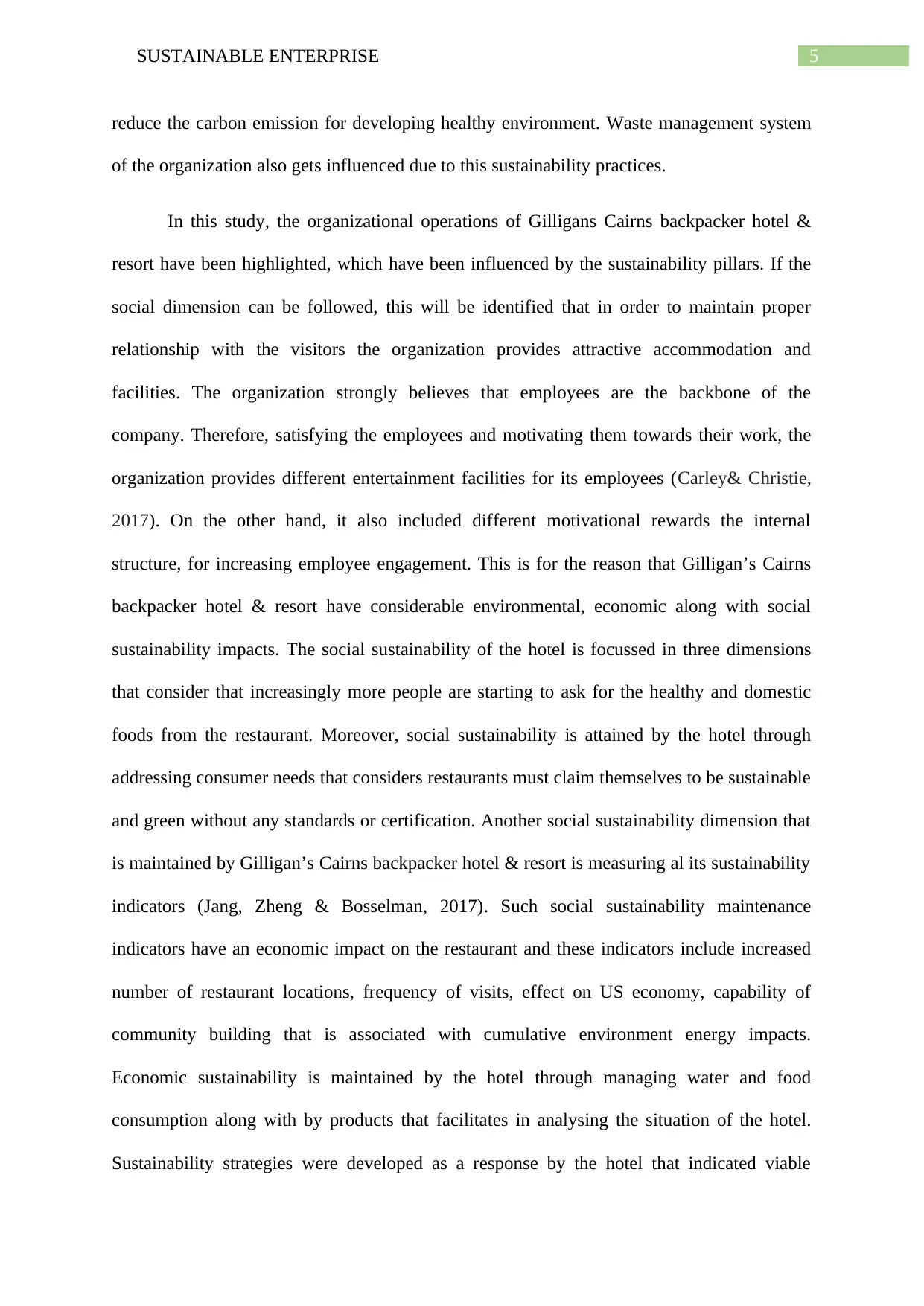
5SUSTAINABLE ENTERPRISE
reduce the carbon emission for developing healthy environment. Waste management system
of the organization also gets influenced due to this sustainability practices.
In this study, the organizational operations of Gilligans Cairns backpacker hotel &
resort have been highlighted, which have been influenced by the sustainability pillars. If the
social dimension can be followed, this will be identified that in order to maintain proper
relationship with the visitors the organization provides attractive accommodation and
facilities. The organization strongly believes that employees are the backbone of the
company. Therefore, satisfying the employees and motivating them towards their work, the
organization provides different entertainment facilities for its employees (Carley& Christie,
2017). On the other hand, it also included different motivational rewards the internal
structure, for increasing employee engagement. This is for the reason that Gilligan’s Cairns
backpacker hotel & resort have considerable environmental, economic along with social
sustainability impacts. The social sustainability of the hotel is focussed in three dimensions
that consider that increasingly more people are starting to ask for the healthy and domestic
foods from the restaurant. Moreover, social sustainability is attained by the hotel through
addressing consumer needs that considers restaurants must claim themselves to be sustainable
and green without any standards or certification. Another social sustainability dimension that
is maintained by Gilligan’s Cairns backpacker hotel & resort is measuring al its sustainability
indicators (Jang, Zheng & Bosselman, 2017). Such social sustainability maintenance
indicators have an economic impact on the restaurant and these indicators include increased
number of restaurant locations, frequency of visits, effect on US economy, capability of
community building that is associated with cumulative environment energy impacts.
Economic sustainability is maintained by the hotel through managing water and food
consumption along with by products that facilitates in analysing the situation of the hotel.
Sustainability strategies were developed as a response by the hotel that indicated viable
reduce the carbon emission for developing healthy environment. Waste management system
of the organization also gets influenced due to this sustainability practices.
In this study, the organizational operations of Gilligans Cairns backpacker hotel &
resort have been highlighted, which have been influenced by the sustainability pillars. If the
social dimension can be followed, this will be identified that in order to maintain proper
relationship with the visitors the organization provides attractive accommodation and
facilities. The organization strongly believes that employees are the backbone of the
company. Therefore, satisfying the employees and motivating them towards their work, the
organization provides different entertainment facilities for its employees (Carley& Christie,
2017). On the other hand, it also included different motivational rewards the internal
structure, for increasing employee engagement. This is for the reason that Gilligan’s Cairns
backpacker hotel & resort have considerable environmental, economic along with social
sustainability impacts. The social sustainability of the hotel is focussed in three dimensions
that consider that increasingly more people are starting to ask for the healthy and domestic
foods from the restaurant. Moreover, social sustainability is attained by the hotel through
addressing consumer needs that considers restaurants must claim themselves to be sustainable
and green without any standards or certification. Another social sustainability dimension that
is maintained by Gilligan’s Cairns backpacker hotel & resort is measuring al its sustainability
indicators (Jang, Zheng & Bosselman, 2017). Such social sustainability maintenance
indicators have an economic impact on the restaurant and these indicators include increased
number of restaurant locations, frequency of visits, effect on US economy, capability of
community building that is associated with cumulative environment energy impacts.
Economic sustainability is maintained by the hotel through managing water and food
consumption along with by products that facilitates in analysing the situation of the hotel.
Sustainability strategies were developed as a response by the hotel that indicated viable
⊘ This is a preview!⊘
Do you want full access?
Subscribe today to unlock all pages.

Trusted by 1+ million students worldwide
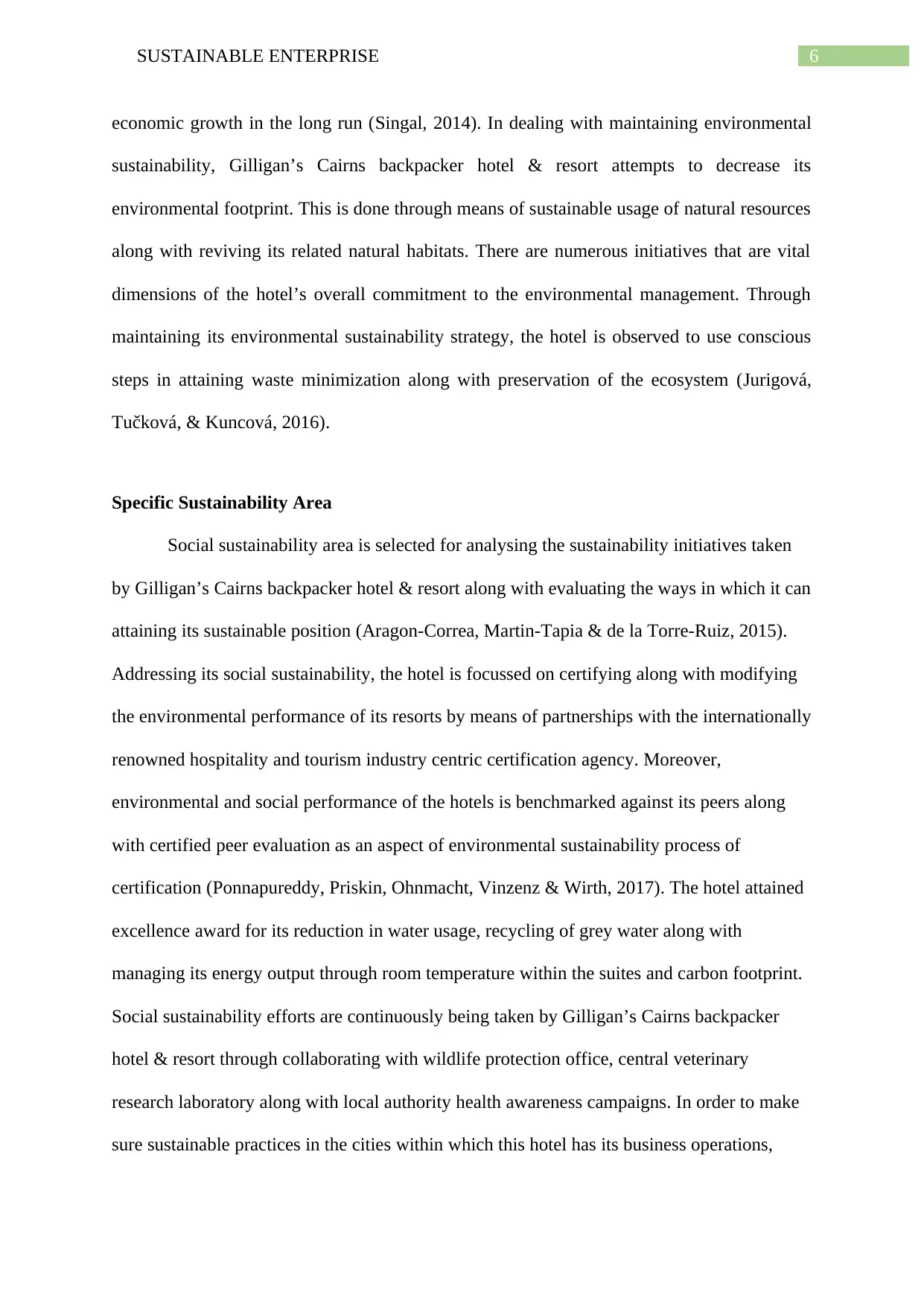
6SUSTAINABLE ENTERPRISE
economic growth in the long run (Singal, 2014). In dealing with maintaining environmental
sustainability, Gilligan’s Cairns backpacker hotel & resort attempts to decrease its
environmental footprint. This is done through means of sustainable usage of natural resources
along with reviving its related natural habitats. There are numerous initiatives that are vital
dimensions of the hotel’s overall commitment to the environmental management. Through
maintaining its environmental sustainability strategy, the hotel is observed to use conscious
steps in attaining waste minimization along with preservation of the ecosystem (Jurigová,
Tučková, & Kuncová, 2016).
Specific Sustainability Area
Social sustainability area is selected for analysing the sustainability initiatives taken
by Gilligan’s Cairns backpacker hotel & resort along with evaluating the ways in which it can
attaining its sustainable position (Aragon-Correa, Martin-Tapia & de la Torre-Ruiz, 2015).
Addressing its social sustainability, the hotel is focussed on certifying along with modifying
the environmental performance of its resorts by means of partnerships with the internationally
renowned hospitality and tourism industry centric certification agency. Moreover,
environmental and social performance of the hotels is benchmarked against its peers along
with certified peer evaluation as an aspect of environmental sustainability process of
certification (Ponnapureddy, Priskin, Ohnmacht, Vinzenz & Wirth, 2017). The hotel attained
excellence award for its reduction in water usage, recycling of grey water along with
managing its energy output through room temperature within the suites and carbon footprint.
Social sustainability efforts are continuously being taken by Gilligan’s Cairns backpacker
hotel & resort through collaborating with wildlife protection office, central veterinary
research laboratory along with local authority health awareness campaigns. In order to make
sure sustainable practices in the cities within which this hotel has its business operations,
economic growth in the long run (Singal, 2014). In dealing with maintaining environmental
sustainability, Gilligan’s Cairns backpacker hotel & resort attempts to decrease its
environmental footprint. This is done through means of sustainable usage of natural resources
along with reviving its related natural habitats. There are numerous initiatives that are vital
dimensions of the hotel’s overall commitment to the environmental management. Through
maintaining its environmental sustainability strategy, the hotel is observed to use conscious
steps in attaining waste minimization along with preservation of the ecosystem (Jurigová,
Tučková, & Kuncová, 2016).
Specific Sustainability Area
Social sustainability area is selected for analysing the sustainability initiatives taken
by Gilligan’s Cairns backpacker hotel & resort along with evaluating the ways in which it can
attaining its sustainable position (Aragon-Correa, Martin-Tapia & de la Torre-Ruiz, 2015).
Addressing its social sustainability, the hotel is focussed on certifying along with modifying
the environmental performance of its resorts by means of partnerships with the internationally
renowned hospitality and tourism industry centric certification agency. Moreover,
environmental and social performance of the hotels is benchmarked against its peers along
with certified peer evaluation as an aspect of environmental sustainability process of
certification (Ponnapureddy, Priskin, Ohnmacht, Vinzenz & Wirth, 2017). The hotel attained
excellence award for its reduction in water usage, recycling of grey water along with
managing its energy output through room temperature within the suites and carbon footprint.
Social sustainability efforts are continuously being taken by Gilligan’s Cairns backpacker
hotel & resort through collaborating with wildlife protection office, central veterinary
research laboratory along with local authority health awareness campaigns. In order to make
sure sustainable practices in the cities within which this hotel has its business operations,
Paraphrase This Document
Need a fresh take? Get an instant paraphrase of this document with our AI Paraphraser
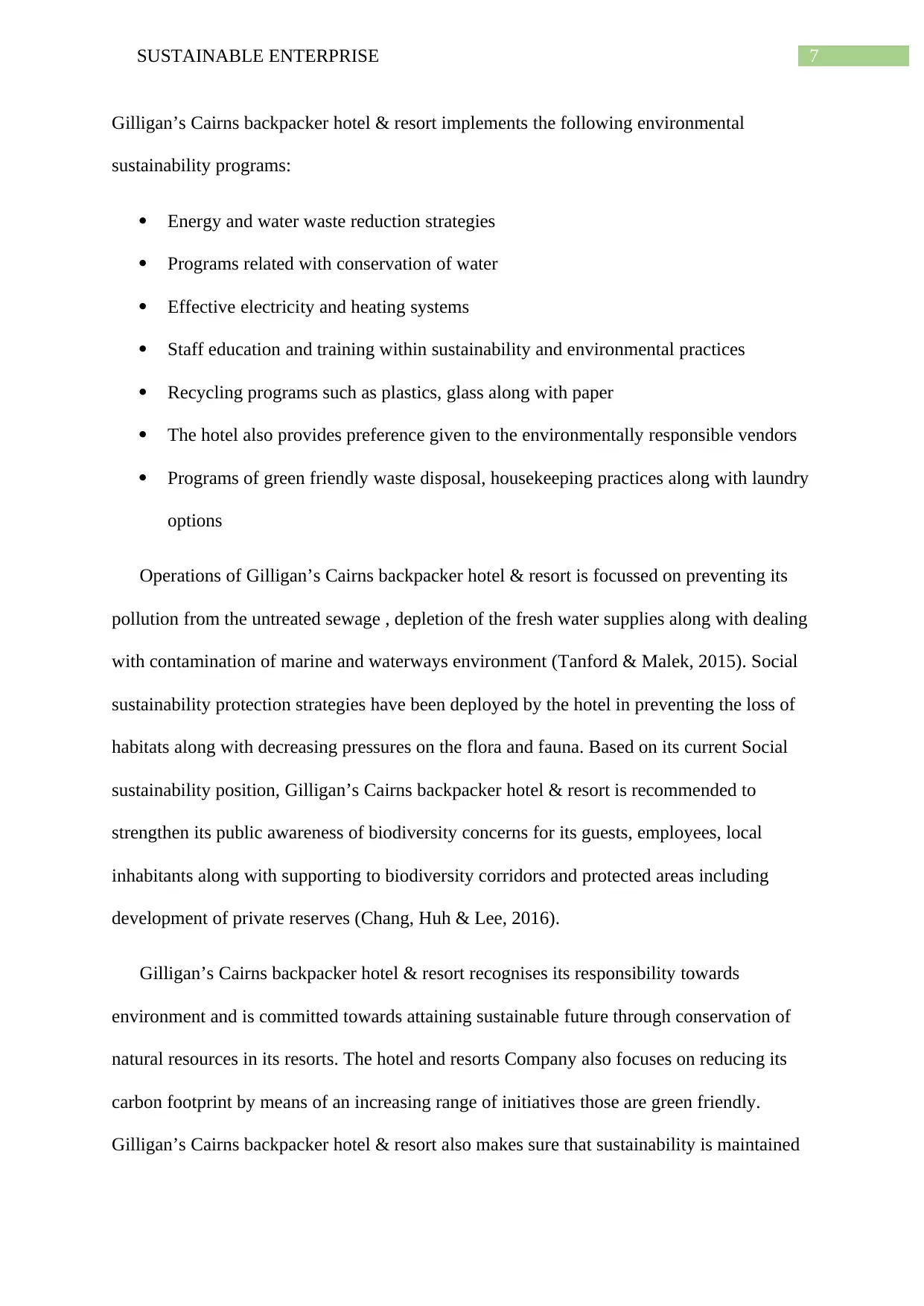
7SUSTAINABLE ENTERPRISE
Gilligan’s Cairns backpacker hotel & resort implements the following environmental
sustainability programs:
Energy and water waste reduction strategies
Programs related with conservation of water
Effective electricity and heating systems
Staff education and training within sustainability and environmental practices
Recycling programs such as plastics, glass along with paper
The hotel also provides preference given to the environmentally responsible vendors
Programs of green friendly waste disposal, housekeeping practices along with laundry
options
Operations of Gilligan’s Cairns backpacker hotel & resort is focussed on preventing its
pollution from the untreated sewage , depletion of the fresh water supplies along with dealing
with contamination of marine and waterways environment (Tanford & Malek, 2015). Social
sustainability protection strategies have been deployed by the hotel in preventing the loss of
habitats along with decreasing pressures on the flora and fauna. Based on its current Social
sustainability position, Gilligan’s Cairns backpacker hotel & resort is recommended to
strengthen its public awareness of biodiversity concerns for its guests, employees, local
inhabitants along with supporting to biodiversity corridors and protected areas including
development of private reserves (Chang, Huh & Lee, 2016).
Gilligan’s Cairns backpacker hotel & resort recognises its responsibility towards
environment and is committed towards attaining sustainable future through conservation of
natural resources in its resorts. The hotel and resorts Company also focuses on reducing its
carbon footprint by means of an increasing range of initiatives those are green friendly.
Gilligan’s Cairns backpacker hotel & resort also makes sure that sustainability is maintained
Gilligan’s Cairns backpacker hotel & resort implements the following environmental
sustainability programs:
Energy and water waste reduction strategies
Programs related with conservation of water
Effective electricity and heating systems
Staff education and training within sustainability and environmental practices
Recycling programs such as plastics, glass along with paper
The hotel also provides preference given to the environmentally responsible vendors
Programs of green friendly waste disposal, housekeeping practices along with laundry
options
Operations of Gilligan’s Cairns backpacker hotel & resort is focussed on preventing its
pollution from the untreated sewage , depletion of the fresh water supplies along with dealing
with contamination of marine and waterways environment (Tanford & Malek, 2015). Social
sustainability protection strategies have been deployed by the hotel in preventing the loss of
habitats along with decreasing pressures on the flora and fauna. Based on its current Social
sustainability position, Gilligan’s Cairns backpacker hotel & resort is recommended to
strengthen its public awareness of biodiversity concerns for its guests, employees, local
inhabitants along with supporting to biodiversity corridors and protected areas including
development of private reserves (Chang, Huh & Lee, 2016).
Gilligan’s Cairns backpacker hotel & resort recognises its responsibility towards
environment and is committed towards attaining sustainable future through conservation of
natural resources in its resorts. The hotel and resorts Company also focuses on reducing its
carbon footprint by means of an increasing range of initiatives those are green friendly.
Gilligan’s Cairns backpacker hotel & resort also makes sure that sustainability is maintained
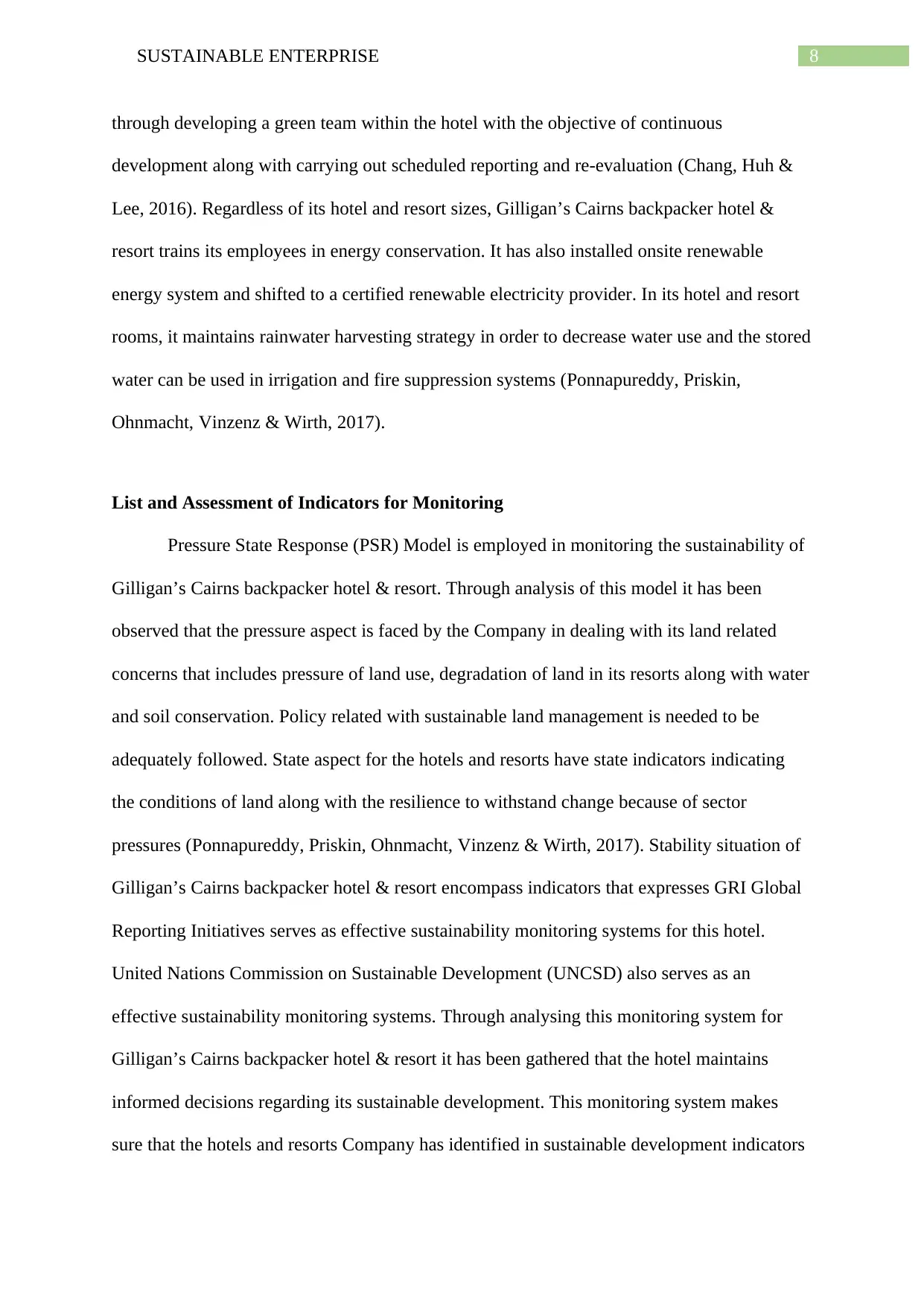
8SUSTAINABLE ENTERPRISE
through developing a green team within the hotel with the objective of continuous
development along with carrying out scheduled reporting and re-evaluation (Chang, Huh &
Lee, 2016). Regardless of its hotel and resort sizes, Gilligan’s Cairns backpacker hotel &
resort trains its employees in energy conservation. It has also installed onsite renewable
energy system and shifted to a certified renewable electricity provider. In its hotel and resort
rooms, it maintains rainwater harvesting strategy in order to decrease water use and the stored
water can be used in irrigation and fire suppression systems (Ponnapureddy, Priskin,
Ohnmacht, Vinzenz & Wirth, 2017).
List and Assessment of Indicators for Monitoring
Pressure State Response (PSR) Model is employed in monitoring the sustainability of
Gilligan’s Cairns backpacker hotel & resort. Through analysis of this model it has been
observed that the pressure aspect is faced by the Company in dealing with its land related
concerns that includes pressure of land use, degradation of land in its resorts along with water
and soil conservation. Policy related with sustainable land management is needed to be
adequately followed. State aspect for the hotels and resorts have state indicators indicating
the conditions of land along with the resilience to withstand change because of sector
pressures (Ponnapureddy, Priskin, Ohnmacht, Vinzenz & Wirth, 2017). Stability situation of
Gilligan’s Cairns backpacker hotel & resort encompass indicators that expresses GRI Global
Reporting Initiatives serves as effective sustainability monitoring systems for this hotel.
United Nations Commission on Sustainable Development (UNCSD) also serves as an
effective sustainability monitoring systems. Through analysing this monitoring system for
Gilligan’s Cairns backpacker hotel & resort it has been gathered that the hotel maintains
informed decisions regarding its sustainable development. This monitoring system makes
sure that the hotels and resorts Company has identified in sustainable development indicators
through developing a green team within the hotel with the objective of continuous
development along with carrying out scheduled reporting and re-evaluation (Chang, Huh &
Lee, 2016). Regardless of its hotel and resort sizes, Gilligan’s Cairns backpacker hotel &
resort trains its employees in energy conservation. It has also installed onsite renewable
energy system and shifted to a certified renewable electricity provider. In its hotel and resort
rooms, it maintains rainwater harvesting strategy in order to decrease water use and the stored
water can be used in irrigation and fire suppression systems (Ponnapureddy, Priskin,
Ohnmacht, Vinzenz & Wirth, 2017).
List and Assessment of Indicators for Monitoring
Pressure State Response (PSR) Model is employed in monitoring the sustainability of
Gilligan’s Cairns backpacker hotel & resort. Through analysis of this model it has been
observed that the pressure aspect is faced by the Company in dealing with its land related
concerns that includes pressure of land use, degradation of land in its resorts along with water
and soil conservation. Policy related with sustainable land management is needed to be
adequately followed. State aspect for the hotels and resorts have state indicators indicating
the conditions of land along with the resilience to withstand change because of sector
pressures (Ponnapureddy, Priskin, Ohnmacht, Vinzenz & Wirth, 2017). Stability situation of
Gilligan’s Cairns backpacker hotel & resort encompass indicators that expresses GRI Global
Reporting Initiatives serves as effective sustainability monitoring systems for this hotel.
United Nations Commission on Sustainable Development (UNCSD) also serves as an
effective sustainability monitoring systems. Through analysing this monitoring system for
Gilligan’s Cairns backpacker hotel & resort it has been gathered that the hotel maintains
informed decisions regarding its sustainable development. This monitoring system makes
sure that the hotels and resorts Company has identified in sustainable development indicators
⊘ This is a preview!⊘
Do you want full access?
Subscribe today to unlock all pages.

Trusted by 1+ million students worldwide
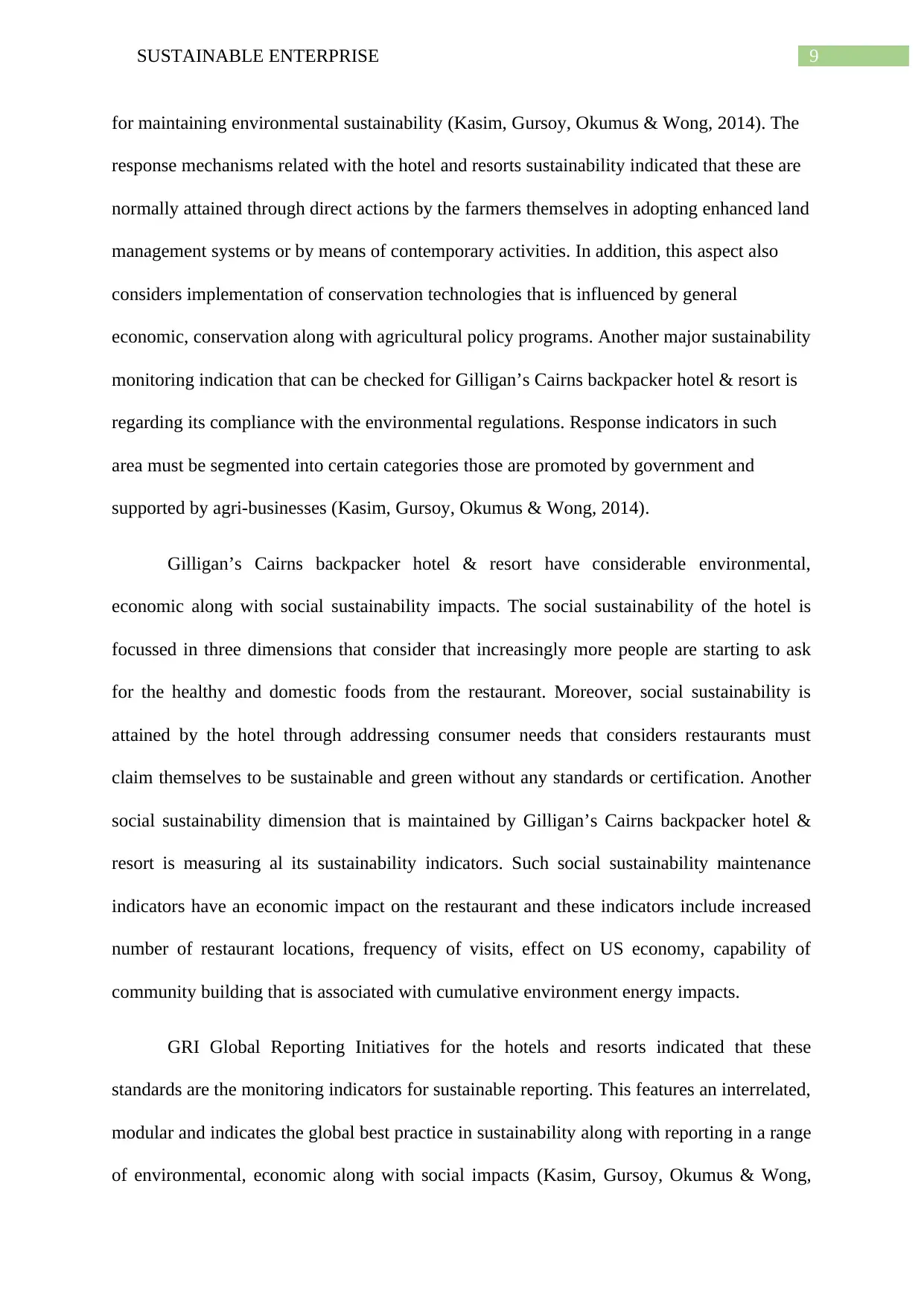
9SUSTAINABLE ENTERPRISE
for maintaining environmental sustainability (Kasim, Gursoy, Okumus & Wong, 2014). The
response mechanisms related with the hotel and resorts sustainability indicated that these are
normally attained through direct actions by the farmers themselves in adopting enhanced land
management systems or by means of contemporary activities. In addition, this aspect also
considers implementation of conservation technologies that is influenced by general
economic, conservation along with agricultural policy programs. Another major sustainability
monitoring indication that can be checked for Gilligan’s Cairns backpacker hotel & resort is
regarding its compliance with the environmental regulations. Response indicators in such
area must be segmented into certain categories those are promoted by government and
supported by agri-businesses (Kasim, Gursoy, Okumus & Wong, 2014).
Gilligan’s Cairns backpacker hotel & resort have considerable environmental,
economic along with social sustainability impacts. The social sustainability of the hotel is
focussed in three dimensions that consider that increasingly more people are starting to ask
for the healthy and domestic foods from the restaurant. Moreover, social sustainability is
attained by the hotel through addressing consumer needs that considers restaurants must
claim themselves to be sustainable and green without any standards or certification. Another
social sustainability dimension that is maintained by Gilligan’s Cairns backpacker hotel &
resort is measuring al its sustainability indicators. Such social sustainability maintenance
indicators have an economic impact on the restaurant and these indicators include increased
number of restaurant locations, frequency of visits, effect on US economy, capability of
community building that is associated with cumulative environment energy impacts.
GRI Global Reporting Initiatives for the hotels and resorts indicated that these
standards are the monitoring indicators for sustainable reporting. This features an interrelated,
modular and indicates the global best practice in sustainability along with reporting in a range
of environmental, economic along with social impacts (Kasim, Gursoy, Okumus & Wong,
for maintaining environmental sustainability (Kasim, Gursoy, Okumus & Wong, 2014). The
response mechanisms related with the hotel and resorts sustainability indicated that these are
normally attained through direct actions by the farmers themselves in adopting enhanced land
management systems or by means of contemporary activities. In addition, this aspect also
considers implementation of conservation technologies that is influenced by general
economic, conservation along with agricultural policy programs. Another major sustainability
monitoring indication that can be checked for Gilligan’s Cairns backpacker hotel & resort is
regarding its compliance with the environmental regulations. Response indicators in such
area must be segmented into certain categories those are promoted by government and
supported by agri-businesses (Kasim, Gursoy, Okumus & Wong, 2014).
Gilligan’s Cairns backpacker hotel & resort have considerable environmental,
economic along with social sustainability impacts. The social sustainability of the hotel is
focussed in three dimensions that consider that increasingly more people are starting to ask
for the healthy and domestic foods from the restaurant. Moreover, social sustainability is
attained by the hotel through addressing consumer needs that considers restaurants must
claim themselves to be sustainable and green without any standards or certification. Another
social sustainability dimension that is maintained by Gilligan’s Cairns backpacker hotel &
resort is measuring al its sustainability indicators. Such social sustainability maintenance
indicators have an economic impact on the restaurant and these indicators include increased
number of restaurant locations, frequency of visits, effect on US economy, capability of
community building that is associated with cumulative environment energy impacts.
GRI Global Reporting Initiatives for the hotels and resorts indicated that these
standards are the monitoring indicators for sustainable reporting. This features an interrelated,
modular and indicates the global best practice in sustainability along with reporting in a range
of environmental, economic along with social impacts (Kasim, Gursoy, Okumus & Wong,
Paraphrase This Document
Need a fresh take? Get an instant paraphrase of this document with our AI Paraphraser
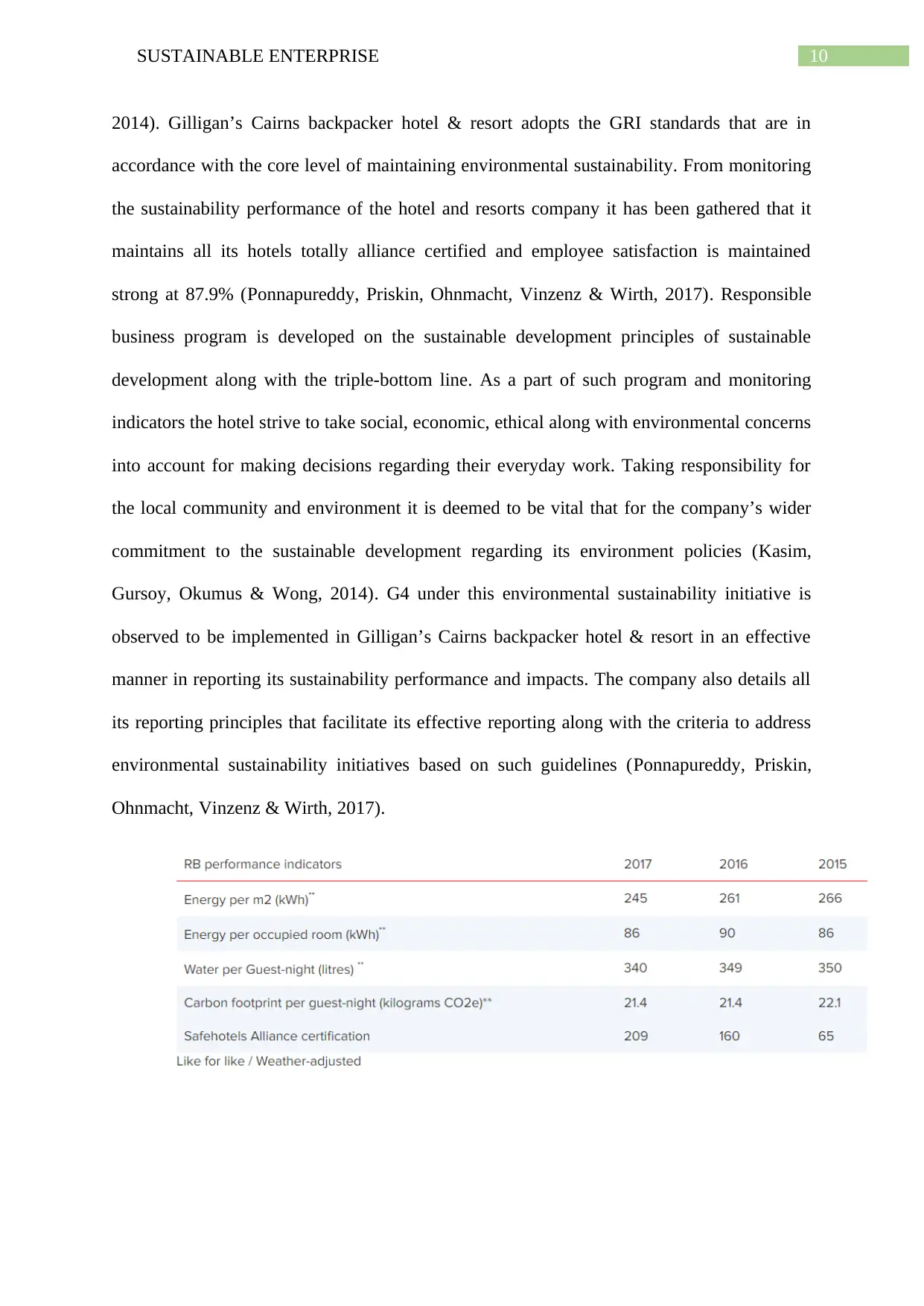
10SUSTAINABLE ENTERPRISE
2014). Gilligan’s Cairns backpacker hotel & resort adopts the GRI standards that are in
accordance with the core level of maintaining environmental sustainability. From monitoring
the sustainability performance of the hotel and resorts company it has been gathered that it
maintains all its hotels totally alliance certified and employee satisfaction is maintained
strong at 87.9% (Ponnapureddy, Priskin, Ohnmacht, Vinzenz & Wirth, 2017). Responsible
business program is developed on the sustainable development principles of sustainable
development along with the triple-bottom line. As a part of such program and monitoring
indicators the hotel strive to take social, economic, ethical along with environmental concerns
into account for making decisions regarding their everyday work. Taking responsibility for
the local community and environment it is deemed to be vital that for the company’s wider
commitment to the sustainable development regarding its environment policies (Kasim,
Gursoy, Okumus & Wong, 2014). G4 under this environmental sustainability initiative is
observed to be implemented in Gilligan’s Cairns backpacker hotel & resort in an effective
manner in reporting its sustainability performance and impacts. The company also details all
its reporting principles that facilitate its effective reporting along with the criteria to address
environmental sustainability initiatives based on such guidelines (Ponnapureddy, Priskin,
Ohnmacht, Vinzenz & Wirth, 2017).
2014). Gilligan’s Cairns backpacker hotel & resort adopts the GRI standards that are in
accordance with the core level of maintaining environmental sustainability. From monitoring
the sustainability performance of the hotel and resorts company it has been gathered that it
maintains all its hotels totally alliance certified and employee satisfaction is maintained
strong at 87.9% (Ponnapureddy, Priskin, Ohnmacht, Vinzenz & Wirth, 2017). Responsible
business program is developed on the sustainable development principles of sustainable
development along with the triple-bottom line. As a part of such program and monitoring
indicators the hotel strive to take social, economic, ethical along with environmental concerns
into account for making decisions regarding their everyday work. Taking responsibility for
the local community and environment it is deemed to be vital that for the company’s wider
commitment to the sustainable development regarding its environment policies (Kasim,
Gursoy, Okumus & Wong, 2014). G4 under this environmental sustainability initiative is
observed to be implemented in Gilligan’s Cairns backpacker hotel & resort in an effective
manner in reporting its sustainability performance and impacts. The company also details all
its reporting principles that facilitate its effective reporting along with the criteria to address
environmental sustainability initiatives based on such guidelines (Ponnapureddy, Priskin,
Ohnmacht, Vinzenz & Wirth, 2017).
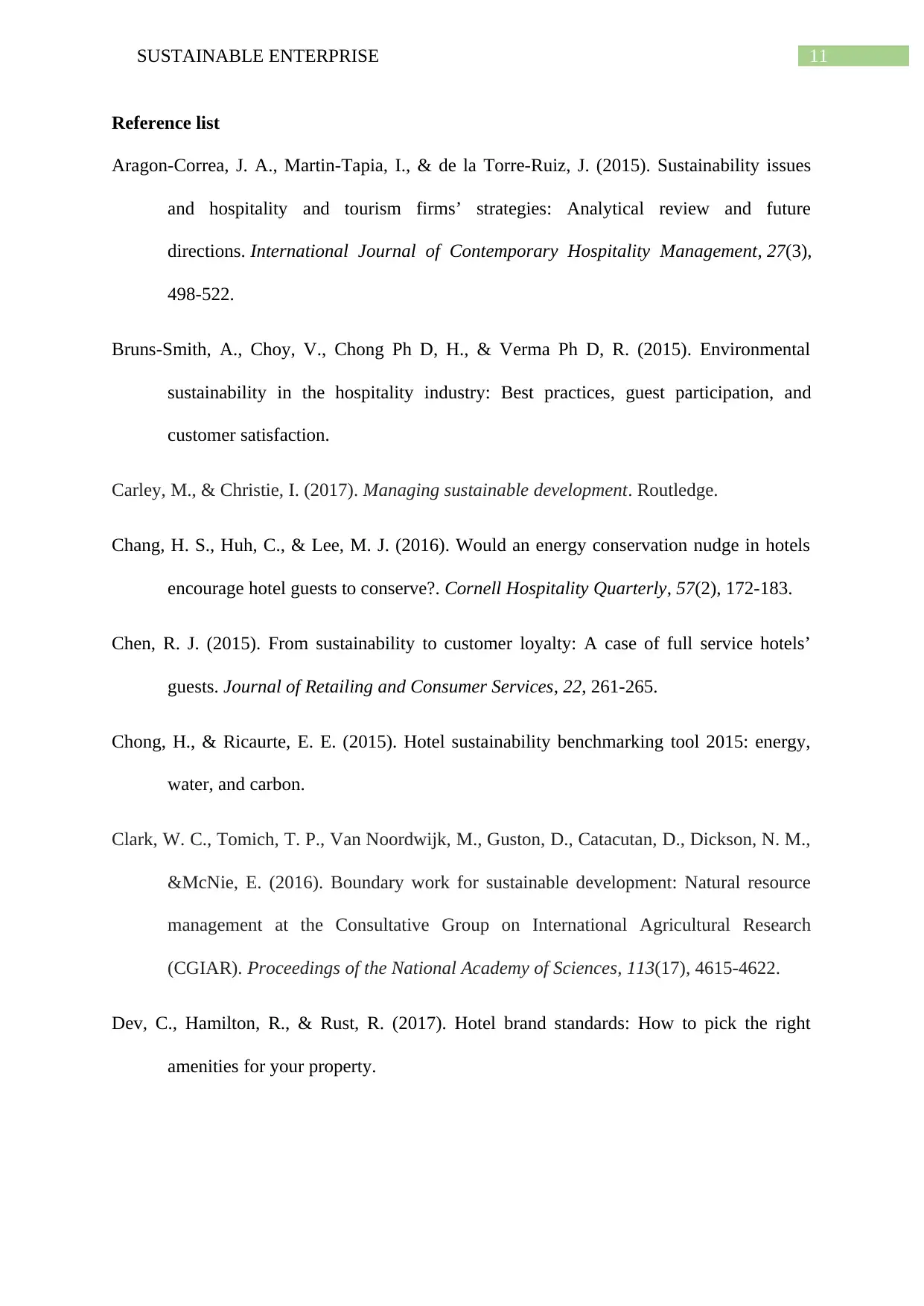
11SUSTAINABLE ENTERPRISE
Reference list
Aragon-Correa, J. A., Martin-Tapia, I., & de la Torre-Ruiz, J. (2015). Sustainability issues
and hospitality and tourism firms’ strategies: Analytical review and future
directions. International Journal of Contemporary Hospitality Management, 27(3),
498-522.
Bruns-Smith, A., Choy, V., Chong Ph D, H., & Verma Ph D, R. (2015). Environmental
sustainability in the hospitality industry: Best practices, guest participation, and
customer satisfaction.
Carley, M., & Christie, I. (2017). Managing sustainable development. Routledge.
Chang, H. S., Huh, C., & Lee, M. J. (2016). Would an energy conservation nudge in hotels
encourage hotel guests to conserve?. Cornell Hospitality Quarterly, 57(2), 172-183.
Chen, R. J. (2015). From sustainability to customer loyalty: A case of full service hotels’
guests. Journal of Retailing and Consumer Services, 22, 261-265.
Chong, H., & Ricaurte, E. E. (2015). Hotel sustainability benchmarking tool 2015: energy,
water, and carbon.
Clark, W. C., Tomich, T. P., Van Noordwijk, M., Guston, D., Catacutan, D., Dickson, N. M.,
&McNie, E. (2016). Boundary work for sustainable development: Natural resource
management at the Consultative Group on International Agricultural Research
(CGIAR). Proceedings of the National Academy of Sciences, 113(17), 4615-4622.
Dev, C., Hamilton, R., & Rust, R. (2017). Hotel brand standards: How to pick the right
amenities for your property.
Reference list
Aragon-Correa, J. A., Martin-Tapia, I., & de la Torre-Ruiz, J. (2015). Sustainability issues
and hospitality and tourism firms’ strategies: Analytical review and future
directions. International Journal of Contemporary Hospitality Management, 27(3),
498-522.
Bruns-Smith, A., Choy, V., Chong Ph D, H., & Verma Ph D, R. (2015). Environmental
sustainability in the hospitality industry: Best practices, guest participation, and
customer satisfaction.
Carley, M., & Christie, I. (2017). Managing sustainable development. Routledge.
Chang, H. S., Huh, C., & Lee, M. J. (2016). Would an energy conservation nudge in hotels
encourage hotel guests to conserve?. Cornell Hospitality Quarterly, 57(2), 172-183.
Chen, R. J. (2015). From sustainability to customer loyalty: A case of full service hotels’
guests. Journal of Retailing and Consumer Services, 22, 261-265.
Chong, H., & Ricaurte, E. E. (2015). Hotel sustainability benchmarking tool 2015: energy,
water, and carbon.
Clark, W. C., Tomich, T. P., Van Noordwijk, M., Guston, D., Catacutan, D., Dickson, N. M.,
&McNie, E. (2016). Boundary work for sustainable development: Natural resource
management at the Consultative Group on International Agricultural Research
(CGIAR). Proceedings of the National Academy of Sciences, 113(17), 4615-4622.
Dev, C., Hamilton, R., & Rust, R. (2017). Hotel brand standards: How to pick the right
amenities for your property.
⊘ This is a preview!⊘
Do you want full access?
Subscribe today to unlock all pages.

Trusted by 1+ million students worldwide
1 out of 14
Related Documents
Your All-in-One AI-Powered Toolkit for Academic Success.
+13062052269
info@desklib.com
Available 24*7 on WhatsApp / Email
![[object Object]](/_next/static/media/star-bottom.7253800d.svg)
Unlock your academic potential
Copyright © 2020–2025 A2Z Services. All Rights Reserved. Developed and managed by ZUCOL.





